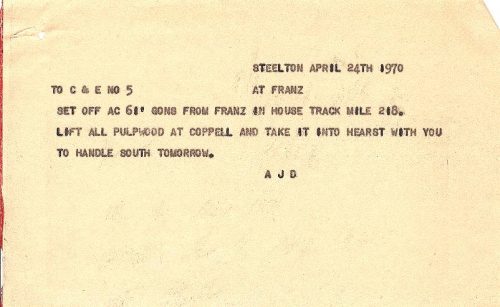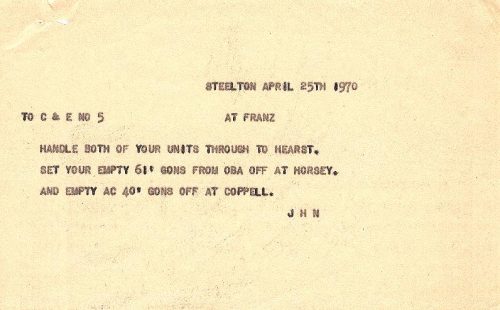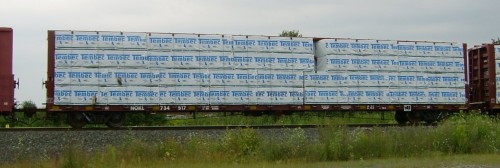Tag Archives: Newaygo Forest Products
Throwback Thursday #2
In the late 1960s-early 1970s Newaygo Forest Products had not yet established the lumber & chip mill at Mead to process logs, but had already been established since at least the 1950s with significant pulpwood loading spurs at Mosher (mile 217.3 & 218.0) and large cutting areas centered around the Mead area with spurs at mile 264.4 (Hale), 275.3 (Mead – where the mill would be built in 1974), and 281.9 (Coppell). During the 1950s up to the early 1970s this raw pulpwood would have flowed south; once the mill was built in the mid-1970s it seems most Newaygo pulpwood was sent to Mead to be chipped, and the woodchips were then shipped south to Wisconsin.
Empty cars would often be stored at nearby sidings at Horsey (273.1) and Coppell (280.9), which is exactly what we see with the message forms below.
These scans are of simple message forms that could have been delivered to train crews along with train orders, but to convey information that is less operationally critical or not covered by the formal forms of train orders.
These messages were all delivered to train no. 5 on successive days from April 24-26, 1970, and there’s a lot of special references to handling empties and pulpwood loads related to Newaygo’s spurs at Mosher, Mead and Coppell.
I believe the railroad term for some of these set-outs of empty cars in the house tracks/sidings at Mosher, Horsey and Coppell would be “constructively placed” – maintaining a ready supply of empty cars nearby for loading at the logging company’s spurs.
61′ gons referred to these messages would of course be the 1001-1400 series bulkhead gondolas built in the mid 1960s. 40′ gons referred to in the second message would have to be cars from the 4601-4804 series (re)built by the ACR’s shops in 1947-48 and still in service in the early 1970s.
The specific references in the last two messages to handling both units (locomotive) through to Hearst are interesting; perhaps it was not uncommon to set off the trailing unit at Oba once all the interchange traffic was dropped off, if there were only minimal traffic left for Mead and Hearst? (Note also that CN freights only operated into Hearst 3 days a week according to the timetable – a frequency Ontario Northland maintains today.)
Throwback Thursday #1
Chips Will Fly at Paper Firm Plant
Mead, Ontario – Newaygo Forest Products Ltd., a subsidiary of Consolidated Papers, Inc., Wisconsin Rapids, Wis., will dedicate its $5.2 million lumber-chip complex here Oct. 6.
The new facility – which has 92,000 square feet of space in five buildings – has the capacity to produce 75 million board feet of lumber and 80,000 tons of wood chips for pulping a year, the company said.
Some of the features, it said, are computer sorting of logs, extensive use of chippers rather than conventional saws and hydraulically powered and controlled equipment.
Newaygo said the complex would enable nearly complete utilization of trees: cutting lumber from the trees fist [sic], chipping what is usually edgings and slabs for pulping and using the bark and sawdust for fuel.
A sister subsidiary of Consolidated Papers, Newaygo Timber Co., Ltd., owns more than 350,000 acres of forest land in the Mead area and will provide most of the logs to be processed in the new facility.
Employment of the two companies is expected to reach 270 when the facility is in full operation. Delays in equipment deliveries have postponed the startup of operations except for the sawmill.
– Milwaukee Journal, Sep. 24, 1974 Sec2, p13
Lumber Traffic on the ACR
Lumber traffic (excluding stuff like plywood, veneer, etc. – we’ll get to that next time) on the ACR consists primarily of four main sources:
- Weyerhaeuser (later Domtar) at Sault Ste. Marie
- Dubreuil Bros. (later Dubreuil Forest Products) at Dubreuilville
- Newaygo Forest Products at Mead
- bridge traffic from Hearst
Weyerhaeuser/Lajambe/Domtar
This mill, located approximately mile 4 in Sault Ste. Marie, produced hardwood lumber and veneers. Established in 1948 as Roddis Lumber & Veneer, in the early 1980s it was owned and operated by Weyerhaeuser Canada. In the mid 1980s Weyerhaeuser sold the mill to G.W. Martin (which also purchased the former Weldwood of Canada veneer mill at Searchmont near the same time). Later ownership changes saw the mill owned by Lajambe Forest Products and later E.B. Eddy and Domtar, with the mill being last sold by Domtar in 2003 to Boniferro Mill Works, which appears to still operate the facility today.
This mill received logs and shipped out finished product by rail. Although I don’t have photos or records to confirm this, I would presume most of their output to be shipped south for export.
Dubreuil Forest Products
The Dubreuil Brothers Lumber Co. established a sawmill just west of Hawk Junction in 1951, and in 1961 moved their operations up to what is now Dubreuilville and established a company town there. During the late 1960s, Dubreuil Bros. began shipping more of their product by truck to Michigan rather than by rail, and sources indicate that from about 1975 through 1986 Dubreuilville was pretty dead as far as rail shipments were concerned, except for a few carloads a year of fresh railroad ties, as they had the contract to supply the ACR.
In about 1986-87 Dubreuil Forest Products switched back to shipping lumber by rail in a big way; tracks were rebuilt and an additional spur for woodchips installed. A second connection was added to the ACR main turning the spur into a wye that could be switched from either direction and yard limits established around the location to facilitate switching. The lumber loading track was able to hold nearly two dozen 60′ cars.
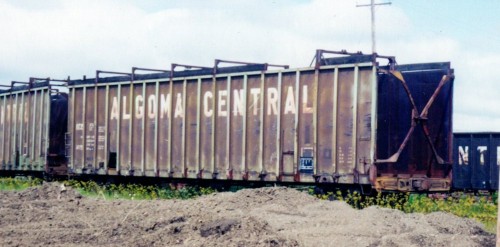
Former woodchip car ACIS 1415 modified as a special lumber car for Dubreuil Forest Products service. Photographed in June 2000 behind the Steelton car shops.
A unique service that the ACR provided at Dubreuilville was using a small fleet of about half a dozen survivors from their former fleet of woodchip gondolas which were modified for lumber service. When switching the mill tracks at Dubreuilville, the ACR would always ensure that one of these was spotted at the end of the track where it would be loaded using a ramp. The loaded cars were delivered to Sault Ste. Marie where Dubreuil used to have a lumber yard adjacent to Steelton yard and unloaded there for transloading onto trucks. Between standard flatcars and these modified chip cars, Dubreuil could load up to a dozen cars per day here.
The Dubreuilville mill closed in 2007, a victim of the general downturn in the Canadian softwood lumber industry at the time.
Newaygo Forest Products
Newaygo Forest Products built their mill at Mead in 1974 to ship out export lumber and woodchips to the US. A couple of sources suggest that a destination for a lot of the lumber produced by Newaygo (and possibly from Dubreuilville as well after Newaygo shut down) was a large modular home builder in Mancelona, Michigan.
The Newaygo mill only lasted in operation until 1984 or 1985.
Bridge Traffic
Additional lumber traffic on the ACR comes from the Ontario Northland (formerly CN) interchange at Hearst. (Today this is the only lumber traffic still operating over the former ACR.)
Significant nearby mills include Lecours Lumber in Calstock (approximately 20 miles west of Hearst), Tembec (former Malette Lumber, former United Sawmills, former Fontaine Lumber) in Hearst and Tembec (former ?) in Kapuskasing. Other lumber comes from a bit farther afield on the ONR and beyond as I’ve also seen lumber from Scierie Landrienne, EACOM (former Domtar mills) and Resolute Forest Products (formerly Abitibi-Bowater) mills in northern Quebec heading towards Hearst via CN and Ontario Northland.

CBRY 1527 with a load of lumber from Scierie Landrienne of Landrienne, QC at Cochrane, ON in a train departing for Kapuskasing and Hearst. July 2013.
Note: I have printable graphics to make your own wrapped lumber loads for most of the companies mentioned above on my Lumber Loads page.
Woodchip Traffic on the ACR
Wood chip traffic on the ACR primarily derived from the sawmills and Dubreuilville and Mead. Both mills were large sources of chip traffic – although not at the same time.
Newaygo Forest Products (Mead, ON)
In 1974 Newaygo Forest Products built a new modern mill 20 miles south of Hearst on the ACR at Mead to produce lumber and wood chips for export to the United States. The woodchips would be shipped to a paper mill in Appleton, Wisconsin.
To supply cars for this traffic the Algoma Central purchased 89 cars from National Steel Car in 1974, with unique ACIS reporting marks designating them under some customs rules or regulations for International Service. A further 23 cars with regular AC reporting marks were added in 1980.
These large capacity cars, the biggest cars on the ACR roster and painted a unique pale green colour with yellow end doors and “billboard” lettering cut a striking appearance, and travelling over almost the entire length of the railway and into Michigan and Wisconsin, there are several good photos of both of these car series available.
They seemed to ship up to about half a dozen cars at a time from Mead, and extra empty cars would often be stored in the siding at Horsey or Coppel, on either side of Mead.
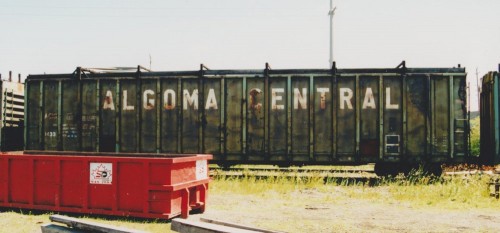
ACIS 1433, one of a few survivors from the Algoma Central’s woodchip car fleet at Steelton yard in 2001. Blair Smith photo.
The mill at Mead shut down in 1985 bringing this traffic to an end.
Dubreuil Forest Products (Dubreuilville, ON)
In about 1986 or 1987, Dubreuil Forest Products installed a new chip spur and loader at their mill at Dubreuilville to load woodchips for the pulp mill on the Canadian Pacific at Marathon.
Cars for this service were 52′-60′ gondolas provided from Canadian Pacific. Over 100 cars were provided, with empties stored in the sidings at Goudreau and Wanda north and south of Dubreuilville to protect the loadings at the mill.
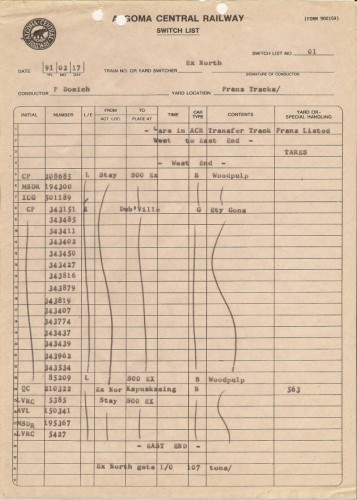
1991 switchlist showing cars in the transfer track at Franz. The dozen empty CP 343xxx series gondolas listed are woodchip cars for Dubreuilville.
Despite the large numbers of car loads involved, since they operated only between the interchange at Franz and the mill at Dubreuilville about 10 miles south, and both locations being a bit more than just slightly off the beaten path, this traffic wasn’t too visible and I haven’t seen much in the way of photographs of these cars in ACR trains, unlike the much more visible AC/ACIS woodchip gondolas that were used to service the Newaygo mill. Fortunately the cars have been well photographed in other locations, particularly as many survivors have recently been used in tie service.
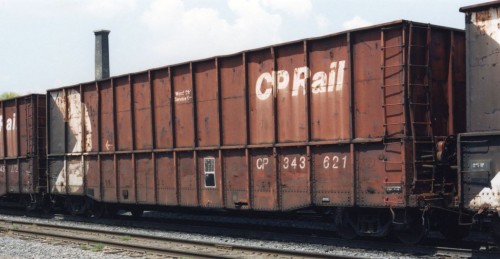
A common variation of CP’s woodchip gondolas rebuilt from a 52′ gondola with extended sides. Bill Grandin photo.
During the 1990s, the AC (and later WC) ran an weekday evening “Franz Turn” out of Hawk Junction to switch lumber and chip loads at Dubreuilville and the interchange at Franz.
The mill at Dubreuilville closed in 2007.
Lecours Lumber (Calstock, ON)
After Newaygo shut down their operations at Mead, the fleet of AC and ACIS woodchip cars were sold off, with many cars being transferred to Newaygo for use on other operations.
One place where ex-Algoma Central cars with Newaygo (NFPX) markings seemed to show up regularly in the 1990s and early 2000s was at the Lecours Lumber stud mill west of Hearst, on trackage now operated by Ontario Northland. These chips apparently headed down into the US somewhere, so by a curious twist of fate, these ex-Algoma Central cars continued to operate over the former Algoma Central rails for several years.
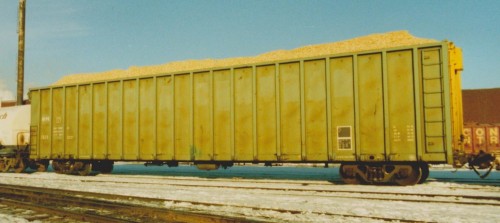
NFPX 1511 with a load of woodchips at Steelton yard, 1999. Blair Smith photo.
I’m not sure when this service ended (or if indeed it still continues on a periodic basis) but in my few visits to the area over the last few years I’ve never seen any chip cars.


